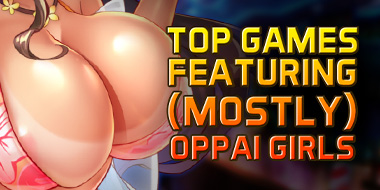History of Mosaic Censorship in Japanese Porn and Hentai Games

- Nutaku
- 2022/09/07
Japan is home to many unique and interesting cultural phenomena. From the rise of the anime industry to the creation of widely known virtual avatars like Hatsune Miku or Kizuna AI, Japan has been at the helm of some truly unique popular pop culture movements. But not everything coming from the Japanese creative world would be considered progressive, at least by western standards.
For many anime and hentai fans, there are few things more frustrating than the history, and present-day standing, of censorship of Japanese porn and other sexual material. Specifically the infamous mosaic censorship in hentai anime and manga. You couldn’t be truly considered a person of culture if you haven't been overly annoyed at one point or another by a bunch of infuriating pixels (or black bars) blocking all the good stuff while you’re trying to have some relaxing private time.
But what is mosaic censorship? Why does Japan blur porn and sexual content? What are their censorship rules? Why do their censorship rules apply to Japanese content that is exported out of Japan? There’s a lot to unpack here, but let’s jump right in and see if we can get to the bottom of the what, why and where!
An Overview of Censorship in Japanese Sexual Content
Ever played a Japanese visual novel and realised that there was a weird blurry pattern over the genitals of the characters? That is called mosaic censorship and it’s the practice of censoring obscene images by obscuring them with a mosaic-like pattern. Mosaic censored porn looks like a bunch of large pixels over the genitals, as if the image was very low resolution. Mosaic censorship can range from simple pixelation, to fogging (light shadow pattern) and in some cases will look like small lines that cross the genitals to hide the overall shape of the characters naughty parts.
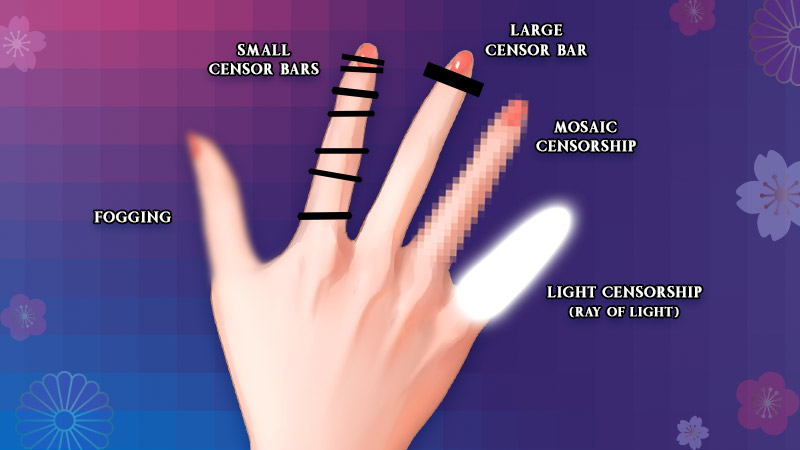
Image: Safe for work example of different kinds of censorship used in Japanese porn and adult content.
Mosaic censorship may be used to hide pubic hair, the full-genitalia area or the anus while in other cases it censors fully part of the screen where a sexual penetration is displayed. Mosaic censorship is only limited to the genitals or sexual action that takes place. Breast or representation of fluid won’t therefore be censored in hentai, but there will be censorship of any type of sexual action that may take place like oral sex, anal sex and other penetrative intercourse.
It’s not uncommon to find censorship in various Japanese content that is shipped overseas. For instance, Ecchi anime that originates from Japan are good examples where cleavage will be hidden, animals will suddenly hide breasts or black stripes are used to hide kisses. Although censorship exists in anime, this notion is especially true regarding Hentai because of the legal definition of Obscenity that still exists in Japanese laws today.
Initially, it’s important to understand that Japanese censorship regulation of sexual material (also called Article 175) is very central in the Japanese pornography industry and that it still exists to this day. The article states that “A person who distributes, sells or displays in public an obscene document, drawing or other objects shall be punished by imprisonment with work for not more than 2 years, a fine of not more than 2,500,000 yen or a petty fine.”
In other words, representation of genitalia or full on penetration in visual art (let it be regular erotic content or Hentai) is considered obscene material under the article 175 of the Japanese law and can be reprimanded. Under these circumstances, the author must censor any type of lewd material that they are planning to distribute in order to obey the law. This regulation is applied to erotic material that is produced in Japan even if the product is meant to be distributed overseas outside of Japan, which would include hentai games.
It’s not unusual for players to notice mosaic patterns in fully translated Japanese hentai games and wonder why they are still there if the game is in English (or another language). It might be easy to say: “Well I am in another country so simply remove the censorship” but the reality is far from being that easy, unfortunately.
There are games which are distributed on Nutaku which contain mosaic censorship, and sadly, this is not a matter that Nutaku has any say in since those types of Hentai games come directly from Japan. Any game that originates from Japan, and is still managed by a Japanese game developer or publisher, cannot have any alteration regarding the sexual censorship.
Japanese adult games, managed by Japanese game teams, need to abide by law 175. From a western point of view it would obviously be ideal to have only uncensored hentai content available, but many Japanese companies hands are tied here.
In order to understand why Article 175 is still present in Japanese law even in modern days, we must dive in and explore a few key historic moments of censorship in Japan and how it developed over time.
The Edo Period and the First Censorship
Censorship has taken many forms throughout Japan's history. Its origin can be traced back all the way to the Edo Period which took place between 1603 and 1867. During this time the Tokugawa Shogunate, a military government that ruled over Japan, oversaw the population and made regulations. The Edo Period was an era of discovery and renewal in Japan. It featured a lot of cultural innovations in various domains that sparked interest and discussion amongst the public. For instance, many subjects like sexuality and new knowledge about religion, other countries' cultural differences and philosophy made their appearance. This was very unique for Japan as they were a country that relies heavily on traditionalism.
These new knowledge and cultural innovations were not driven by the military government and the samurai rulers. Instead they came from Japanese merchants that met unique individuals during their travels and exchange with overseas merchants. Not only did they learn interesting new knowledge and concepts but they also visited unique establishments that were popular at the time.
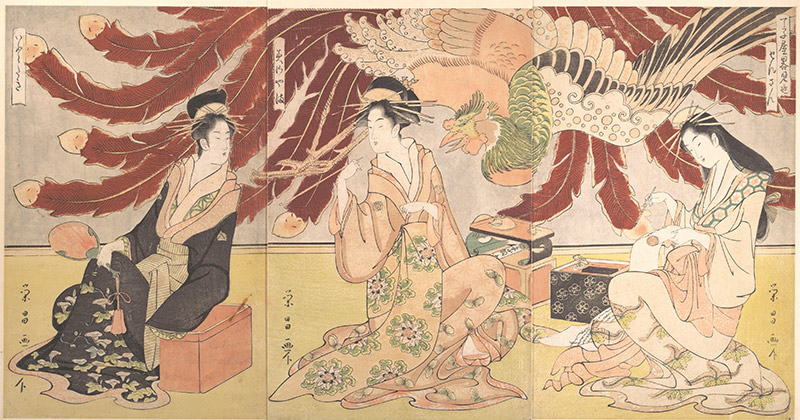
Credit: The Chōjiya Pleasure House by Day (Chōjiya hiru-mise), Chōkōsai Eishō (Japan, 1798)
Amongst these influential locations were pleasure quarters. These establishements were special brothels where you could pay to have sex and most villages had one. Although these were badly viewed by the higher class at the time, pleasure quarters were quite popular for common folks. They were also very popular amongst overseer merchants that didn't miss an opportunity to visit them when they were in town. Quickly, pleasure quarters became a location for culture exchange amongst the common folks and slowly but surely a staple for changes in Japanese society. As their popularity grew and information about these places were shared by travelling merchants, more and more people visited these places.
The pleasure of sexuality and erotism that could be found in these establishments pushed a large number of artists to create new kinds of unique artwork. This was a new phenomena that gave a meaning and power to the brothels. Most of these artworks represented the euphoria and sexual satisfaction that could be found in these places. Their art quickly became a popular subject amongst the common folks and again their popularity grew quickly. Soon enough as brothels' reputations changed, the workers within the organisation began to have more power and say. For instance, sex workers were not seen anymore as low-class individuals, but instead people viewed them as well respected figure.
This sort of change created a distortion amongst the traditional ways of the social hierarchy. More specifically, lines were slowly getting blurred between social rank as sex workers became idolized and had greater power than before. The art made during this time pictured them as beautiful goddesses that would share their beauty with the world. As these type of new erotic material spread, sex workers popularity what as its peak. This sparked frustration amongst the bureaucrats, who viewed themselves as too high class for lewd works of art. They saw this type of transgression as a menace to the order that was in place at the time.
Seeing the sex workers thriving and the amount of erotic content produce pushed the Tokugawa Shogunate to create the first censorship laws to exist. This law was aimed at reducing the amount of sexual material that was produced. Not only this, but it also meant to regulate how much erotic material was shared amongst the townsfolk. The Tokugawa rulers were not against content showing nudity or intercourse, per se, but they were instead very much against the idea of disrupting the order of the social classes that was currently in place.
This is where the first form of censorship took place regarding sexual relationships shown on paper. The Tokugawa Shogunate made a regulation around 1722 that documents or art pieces showing nudity needed to be either completely blurred or other forms of censorship were necessary. In some cases books were banned and removed from people and vendors selling them. The public greatly disagreed with these new rules, which sparked a rise of civil disobedience. People used literature and art to actively fight the censorship that was put in place by the government. This sparked years of social disobedience until Japan changed drastically their political system leading to a new period called the Meiji Period.
The Meiji Period and the Banned of Erotic Content
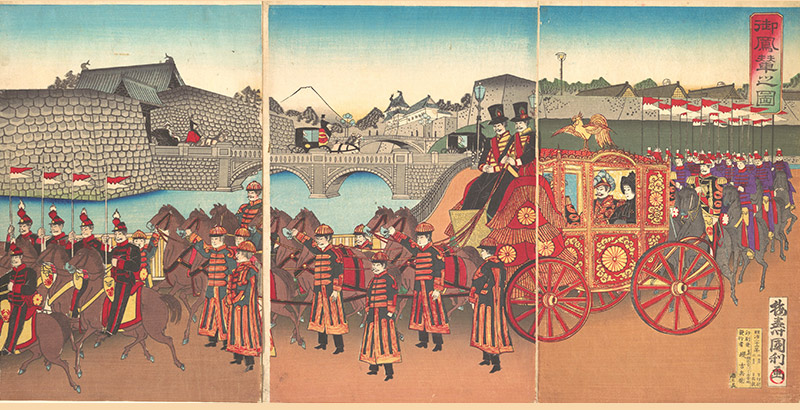
Credit: View of the Imperial Carriage, Utagawa Kunitoshi (Japan, 1889)
Laws restricting erotism and sexual materials remain active until the Meiji Restoration occurred in 1868. The Meiji Restoration was a huge revolution of the political system. It consolidated the power of the country under one ruler: the emperor of Japan. With this new regime also came new laws that were aimed at fighting social disobedience. Although the censorship laws were still active, social disobedience was at its peak at the end of the Edo period. This led the new Meiji regime to act quickly and change how laws worked in regards to anything related to art which included erotic material. Since this new regime was greatly influenced by the west, they wanted to go further than the previous government. Instead they wanted to see all forms of content showing nudity and sexual activities banned, destroyed and pulverized to small pieces.
Although, pleasure quarters establishments remain active, everything that was considered erotic media was forbidden in the country. This became further true when the Article 259 was put in place which stated: “A person who distributes or sells an obscene writing, picture or other object or who publicly displays the same, shall be punished with imprisonment at forced labour for not more than two years or a fine of not more than 5,000 yen or a minor fine. The same applies to a person who possesses the same for the purpose of sale.”
This marked the first time that the word Obscene was used to describe erotic content. It was an abstract term that meant that any erotic material was unable to be published or displayed. The ambiguity of the law left a lot of power to the authorities making the production of erotic material a risky business. Even more dramatic, the authors could not bypass the law like before by using blurring or fogging of sexual images before. It was now left to the authorities to decide whether the censorship of a material was deemed enough. As you might have guessed, in most cases it obviously wasn’t.
The article 175 was then also added to further specify the distribution of such material: “A person who distributes, sells or displays in public and obscene document, drawing or other objects shall be punished by imprisonment with work for not more than 2 years, a fine of not more than 2,500,000 yen or a petty fine. The same shall apply to a person who possesses the same for the purpose of sale.” This article served as the final nail in the coffin for artists who wanted to draw nude content and sexual intercourse. The consequences of getting caught producing or distributing these types of material were now made even worse.
People still tried to publish erotic books overseas, but in 1910 the government put in place the Customs Standards Law. It applied the article 259 regulations to overseas content that was entering the country through customs. This meant that the same regulation regarding the censorship and distribution of material was attributed to everything entering the country. The worst came in 1930 when the death penalty was added to the list of possible punishment for certain offences. As you might have guessed, it made things even more complicated for anyone trying to produce erotic material. This was simply a new form of censorship that was added to the list as Japan became more militarized. War was on the horizon.
The Occupation Period and Changes to Regulation
In 1940, World War II began officially when the Japanese army seized Manchuria. This led to 5 years of war and brutal international conflicts that affected many people. Then in mid-August 1945 the United States dropped nuclear weapons on Hiroshima and Nagasaki. In the wake of these events, the emperor of Japan surrendered which ended World War II. This began a new chapter in Japan’s history as it became under occupation by the Supreme Command for the Allied Powers (SCAP). The SCAP was a United State organization that was aimed at suppressing Japan's military nationalism.
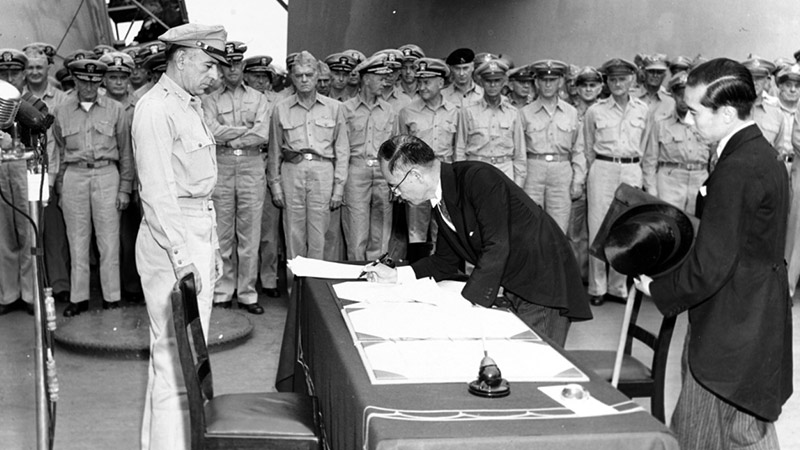
Credit: Surrender of Japan, LT. Stephen E. Korpanty; restored by Adam Cuerden (Tokyo Bay, 2 September 1945)
Quickly the SCAP began to dismantle the Japanese censorship laws that were put in place during the Meiji Period. This was mostly aimed towards military propaganda which left one thing out… erotic material. Indeed, as many domains had their censorship remove, erotic material was still under the article 175. Local police were now in charge of analyzing sexual content leaving them to be the judge if something was considered obscene. This left some room to authors to publish interesting erotic novels since things were not as strict as before. That being said, doing so also included many risks. From time to time, certain authors or publishing houses were arrested or fined large amounts of money. Things were not as bad as before, but still censorship remained necessary.
The occupation of Japan then came to an end in 1952. This left the new government in place to create new regulation and changes to censorship laws. This pushed the officials through a series of judicial decisions in 1957 to define the term “obscenity” of censorship law. Before this, the term was always left to the discretion of people executing the law which was very problematic. It was easy for people who morally disagree on the subject to quickly judge something as obscene. The new legal interpretation stipulated that something is obscene if it “arouses and stimulates sexual desire, offends a common sense of modesty or shame, and violates proper concepts of sexual morality.” This meant that under this law using mosaic censorship over genitalia was enough and made the material technically legal.
Furthermore, a new self-regulated mechanism was put in place regarding erotic content. Censorship would be up to the publishing house or the TV station to auto-implement on their material. Not only was this simpler for authors but it also left some room for them to experience. That's when mosaic censorship and fogging came back again in full force since using it made the material legal. With the censorship law still fully in place came the rise of doushinji in 1960. They were self publicized erotic books where authors would push the boundaries of what was considered legal. In some cases authors would sell art that was deemed illegal as a form of civil disobedience, similar to the Edo era.
The 1980s, Tentacles and Modern Legislation
Then, in the 1980s, came the anime and hentai ascension to become slowly but surely what it is today. It took place mostly because of the technological boom that occurred during this time. Technology made overseas erotic content a lot more accessible in Japan and since they were not made in Japan, the censorship laws did not applied to them. This pushed a few Japanese authors to find ways to bypass article 175 using various interesting method and this why tentacle pornography was born!
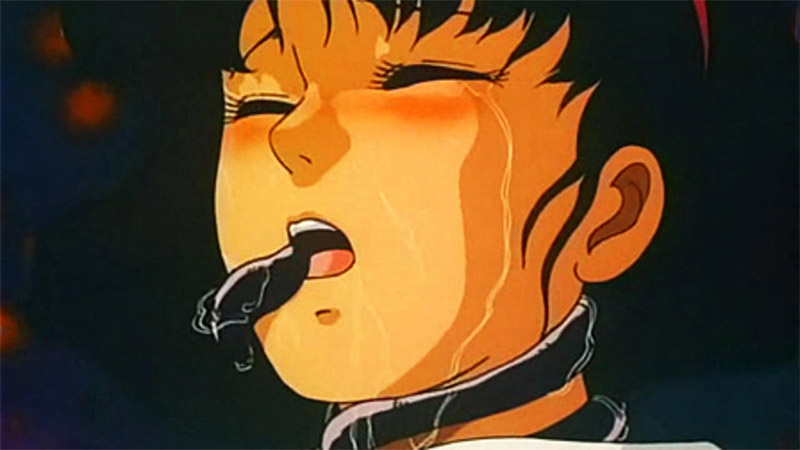
Credit: Image from Demon Beast Invasion OVA from the creator Toshio Maeda in 1990.
The author Toshio Maeda in 1990 wrote a manga called Demon Beast invasion where he had the idea to use tentacles for penetration. Since tentacles or similar object were not considered men's genitals, authors were allowed not to censor the object, although the penetration was hidden behind mosaic censorship. This is when the tentacle genre was born and spawned multiple different series using the same type of visual representation.
Through all of these changes regarding censorship, the law, the government and even post-war the article 175 regarding distribution of obscene material remain active.
In 2011, the article was even updated to add recording media. This means that as of 2011, electronic or magnetic records are also subjected to the law. This means that although it is self-regulatory meaning that the author is free to censor things their way, erotic material needs to be censored to this day! Furthermore, any sexual content that is produced in Japan must abide article 175 even if it is exported outside of Japan. So what does this mean? An ecchi anime where you can see somebody naked? Genitalia needs to be censored. A doushinji showing full penetration? The penetration has to be censored. And finally… you have guessed it, an hentai game produce in Japan showing people having sex? Censored.
There you have it, the reason why mosaic censorship exists and is still very important today! There are many opinions from all sides on whether censorship in otaku culture is still relevant today. Discussions even arose in the public and from politicians a few years ago for things to change. Sadly, nothing really changed and things are still the same today. With no clear indication that this law will be removed in future, it’s still a reality for authors.
For more history about how Hentai influenced the otaku culture checkout how anime was changed by Hentai article.



